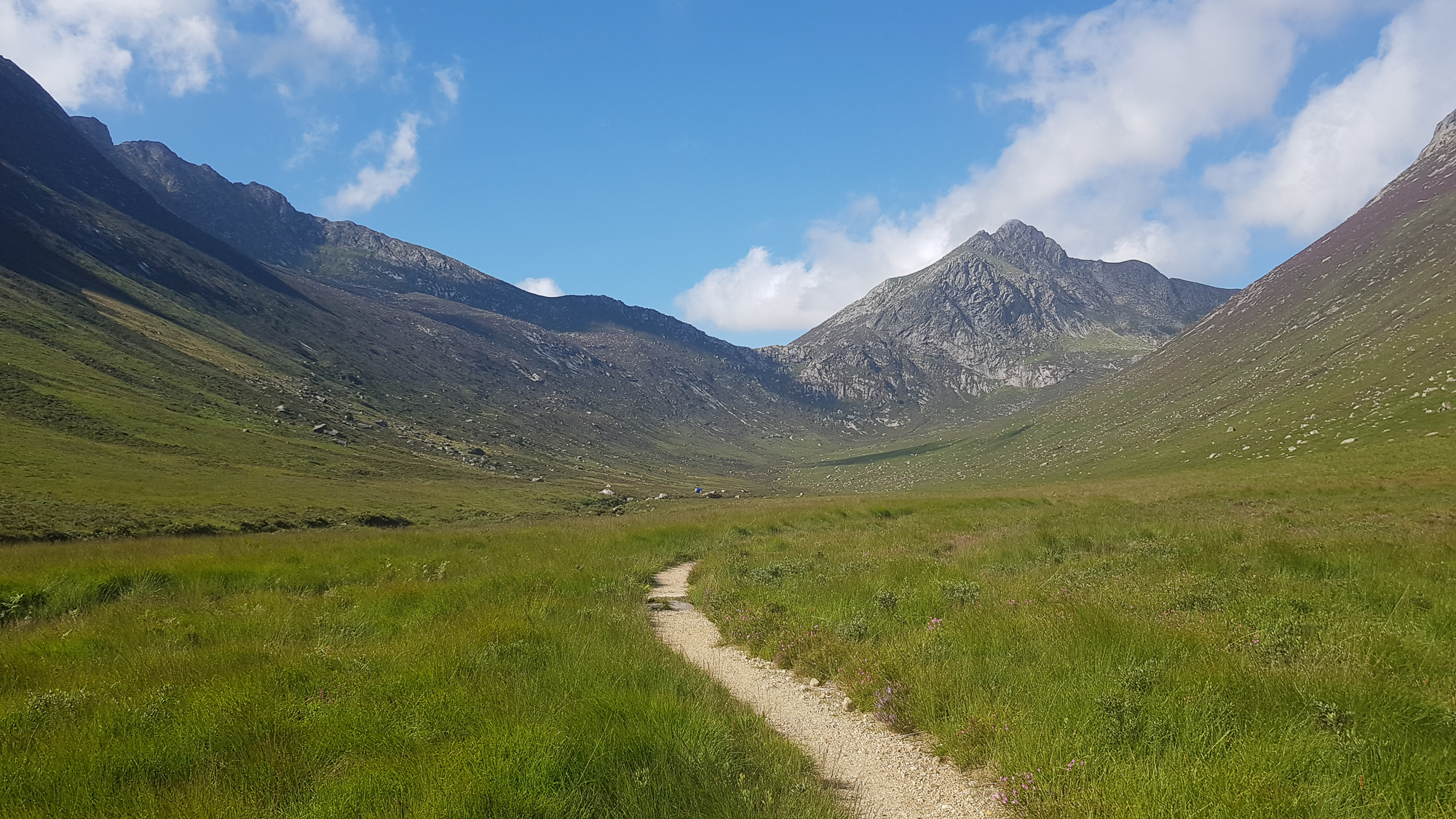
Glen Sannox, Arran
VC 100 consists of a number of islands that are found in the firth of Clyde on the west coast of Scotland. The largest island within the vice county is Arran which offers the greatest bryological interest simply by how large it is compared to other islands and the associated diversity in habitats and geology. Other inhabited islands found within VC 100 include Bute and Great Cumbrae and Holy island. There are also some other islands though these are often very small and uninhabited (e.g. Inchmarnock, Pladda and Little Cumbrae).
Current recording status:
Intermittent recording is being carried out, with a focus on tetrad recording and re-finding rare and scarce records. Targeted recording is normally carried out at a tetrad level, though most records are assigned to at least monad level.
Key sites on the Isle of Arran
Mountains

Arran mountains
The northern half of the Isle of Arran is dominated by mountains, the largest of which is Goatfell that measures 874m Above Sea Level (ASL). Many montane and sub-montane species have been recorded here including Conostomum tetragonum, Ditrichum zonatum, Oedipodium griffithianum and Pleurocladula albescens, though the latter species has not been recorded or re-found since its initial discovery in 1840. A recent BBS trip to Glen Sannox produced new populations of Herbertus aduncus subsp. hutchinsiae, Bazzania tricrenata, Campylopus setifolius, Campylopus atrovirens var. falcatus and Marsupella stableri.
Glenashdale falls – NS 03 25
This is a rather nice, wooded glen with a river and some large waterfalls. It is located in the southern half of the Island at Whiting Bay. The woodland immediately surrounding the watercourse is deciduous, though this is quickly lost to commercial conifer plantations which are the dominant habitat type in this area. The ravine itself is quite rich in bryophytes where species such as Cololejeunea microscopica (Aphanolejeunea microscopica), Molendoa warburgii and Hygrobiella laxifolia can be found. Small Lejeunea species are frequent as epiphytes on many of the surrounding trees surrounding the watercourse including Lejeunea patens, L. cavifolia and L. lamacerina.
Cock of Arran – NR 95
This site can be found by walking from Lochranza along the north-eastern shoreline. The geology is varied and provides a rich bryophyte assemblage. Species favouring base-rich conditions in this location include Scapania aequiloba, Tortella nitida and Tortella fasciculata. Oceanic species are also very well represented and diligent searching can reveal species such as Lepidozia cupressina, Plagiochila punctata, Plagiochila spinulosa and Pseudomarsupidium decipiens (Adelanthus decipiens). This is also the only location in the vice county where Calypogeia suecica has been recorded.
Key sites on the Isle of Bute
Bute was reasonably well recorded during the late 1980’s to the mid 1990’s by K.M. Cocking and Gordon Rothero. As a result, many of the most notable areas have received some attention, though as usual… there is always much more to explore!
Balnakailly Wood in the North end of Bute SSSI holds many notable oceanic and sub-oceanic records such as Plagiochila punctata, Pseudomarsupidium decipiens (Adelanthus decipiens), Sphenolobus minutus (Anastrophyllum minutum), Lepidozia cupressina, Cololejeunea microscopica (Aphanolejeunea microscopica) and Drepanolejeunea hamatifolia.
Kirk Dam in the centre of Bute is also worth exploring as this was the first (and at the time of writing, one of only two) locations for Riccia huebeneriana in Scotland.
Great Cumbrae
While many records exist for Great Cumbrae (and indeed some for the uninhabited Little Cumbrae!) Most of the records are not localised to a particular area within the islands. Some recent records have been added that are at a monad or tetrad scale, but most of the sites that were covered at this scale were rather non-descript in their bryological assemblage. Any future recording on the island would benefit from recording sites at a tetrad or monad level to further narrow down the distribution of species on the island.
Rory Whytock, October 2020
